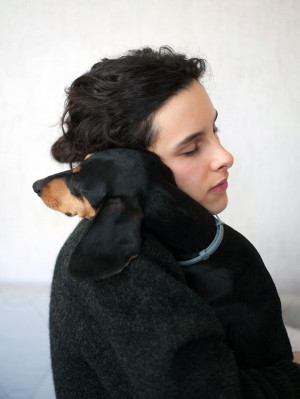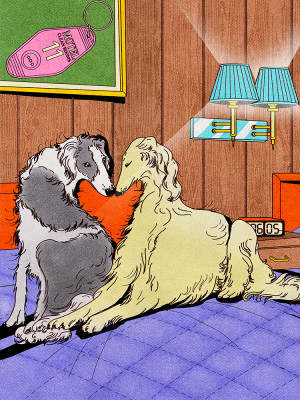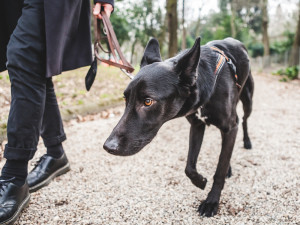Will My New Dog Ever Love Me?
What to do when you don’t feel the close bond you want

Share Article
Five months ago, I adopted an 18-month-old dog from a friend. I’ve potty trained her, given her the best foodopens in new tab, and walk her daily and she’s much better behaved and less neurotic than when she was with her original person. But she is not very affectionate with me, and when her former person visits, she wants to leave with him. Sometimes, she’s even more affectionate with my friends than she is with me. It’s very painful, and I’m wondering whether this will ever change.
Being rejected by a dog is a whole new level of heartbreak. Every pet parent wants to have a close-knit bond and loving relationship with their dog, but it can be a struggle for some dogs – and it’s not always anyone’s fault. Like humans, dogs might not mesh with someone for a variety of reasons, like their own personality, fear, anxiety or maybe some factor the dog just doesn’t agree with. The good news is, hope isn’t lost. Below are a few things you can try to help improve your relationship with your dog.
First, let’s state the obvious
We know you know, but it has to be said: if you want your dog – or anyone – to like you, you have to be nice. Make sure that nothing you’re doing is aversive to your dog. Given how deeply devoted you are to your dog, you’re likely not using any kind of physical punishment, harsh words or yelling at her. Such things are counterproductive to a loving relationship.
Next, check your clothing and home decor
See if something innocuous to people (and most dogs) is making your dog uncomfortable and limiting the growth of your friendship. Sometimes a problem is simple, yet easy to overlook. For example, many dogs dislike floral and citrus scents, so if you use perfume, shampoo or detergent with those fragrances, that may make her less likely to snuggle up to you.
It could have something to do with noise, such as jangly bracelets or clothing fabrics that make a whooshing sound. Thoughtfully consider any sensory stimulation that may upset her and experiment to see if changes make a difference.
Then, check your own behaviours
Beyond the obvious, there are some things that people do that dogs tend to dislike, whether it be hugs, pats on the head, or stroking them in an uncomfortable way. Pay attention to their body language as you interact with your pup to ensure there are no signs of stress. Many dogs really enjoy some kinds of touching, but not others.
Typically, dogs like being rubbed slowly on their chest, stroked down their back and scratched just above their tail. Some like to have their ears gently rubbed. As a general rule, many dogs do not like to be touched or patted on top of the head, being picked up, physically put into position, or forced in any way. Hugging is often not well received, and few dogs like having their feet touched. Pay close attention to the way others stroke your pup, including the visiting friends who bring out her more affectionate side and replicate their actions. Let your dog choose to come to you rather than pursuing her.
Build your bond through training
Even though it sounds like work, training can be very bonding. During training, your dog will receive all kinds of positive attention, and both of you are working together towards common goals and sharing the joy of accomplishing them. It may be more fun to work on tricks such as ‘crawl’, ‘high-five’, and ‘sit pretty’ rather than focus on typical skills like ‘stay’, ‘heel’ and ‘lie down’.
When teaching tricks, there’s less pressure to succeed and many ways for the dog to be right. Or consider taking a positive-methods training class with her. Though you mention that she is well-behaved, there is much to be gained from sharing the experience of participating in training. Think of the class as a fun activity to do together rather than a task to be accomplished.
Last, play with your pup more
Focus on having fun together. Many dogs love to play and wish we’d do more of it with them. While it’s easy to do things for our dogs, our time would also be well spent doing more things with them. Try out fetch, tug, chase or searching games to see what she most enjoys, and offer her balls, ropes and squeaky toys to discover what makes her happy.
It’s clear that you love this dog very much and are committed to the relationship, which is the most promising sign that it will continue to grow as you would like it to. It might take time, but if you continue to show her care and fill her life with joy, she’ll eventually associate you with safety and happiness – and hopefully snuggle up for some coveted cuddles.

Karen B. London, PhD, CAAB, CPDT-KA
Karen B. London, Ph.D., is a Certified Applied Animal Behaviorist and Certified Professional Dog Trainer who specializes in working with dogs with serious behavioral issues, including aggression, and has also trained other animals including cats, birds, snakes, and insects.
Related articles
![A side profile photograph of a woman with her eyes closed holding her dog in her arms, who is resting their head on her shoulder.]()
How Anthropomorphisation Makes You a Better Pet Parent
What are the benefits of our pets’ human personalities? Psychotherapists and animal behaviourists weigh in
![Man hugging his fluffy white dog happily]()
Chemistry Between People and Pets Is Real (It’s Science)
How the ‘love hormone’ oxytocin connects us with our pups
![An illustration of 2 dogs on a bed]()
Three’s a Crowd: When One Partner Doesn’t Want the Dog in the Bed
You want them to cuddle up; your partner doesn’t. Here’s how to handle the great bed debate
![A woman wearing a yellow headband and a white off-the-shoulder shirt with blue jeans and platform black flower boots kneeling next to her black Poodle mix dog on the lawn outside]()
How to Teach Your New Dog Your Name
Your dog might not know your name. Don’t take offence – just play this game
![Female dog trainer raising a treat above a beagle dog's head]()
Your Dog’s Trauma Triggers Are Everywhere. Fear Free Training Can Help
The founder of Fear Free Pets, Dr Marty Becker, on how this method makes vet visits, training sessions and grooming appointments less stressful for pets
![Shy black dog walking with owner at the park.]()
How to Help an Anxious Dog Conquer Their Fears
Six animal behaviourists share pro tips for boosting the confidence of a fearful dog









